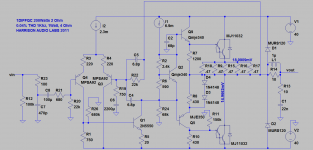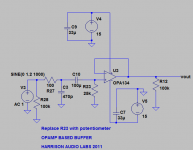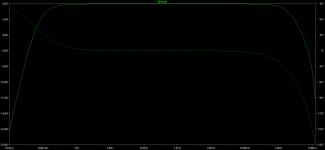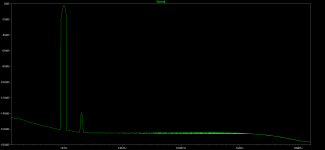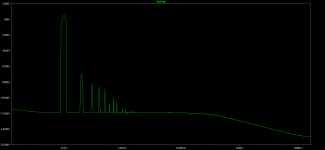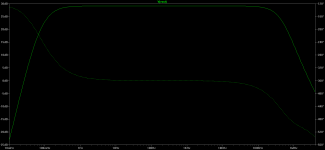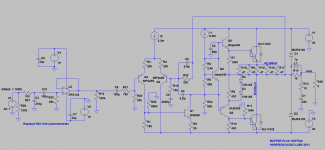buffer
One could use a buffer of their choice. However an opamp based buffer will also work out. Here attached is an opamp based buffer. Opamp choice is flexible. The fourier analysis is for +-1.2v output.
One could use a buffer of their choice. However an opamp based buffer will also work out. Here attached is an opamp based buffer. Opamp choice is flexible. The fourier analysis is for +-1.2v output.
Attachments
I am intrigued, explain what made you do this.
Well Nico, its a long story but this might help
Faster than light particles found, claim scientists | Science | The Guardian
Here is the integrated amplifier. THD is 0.02% 1Watt, 1Khz,4Ohm, the Fourier is attached. THD is at 0.07%, 295Watts, 1Khz, 2Ohm.
Hi OnAudio,
It is working on actual? Thanks
Regards,
Boyet
Hi OnAudio,
It is working on actual? Thanks
Regards,
Boyet
Hi Boyet,
It will indeed work as designed. What I have come up with is a formula for creating great sounding amplifiers (It will hopefully be published soon). I have used this formula against the best reviewed amplifiers and all checks out so far. What I need now are the ears of diyers like you to tell me whether I am right or wrong
Hi Boyet,
It will indeed work as designed. What I have come up with is a formula for creating great sounding amplifiers (It will hopefully be published soon). I have used this formula against the best reviewed amplifiers and all checks out so far. What I need now are the ears of diyers like you to tell me whether I am right or wrong.
Hi OnAudio,
Thank you OnAudio for your reply..I have checked in our local store the availability of MJ11032 and I found it.. I'll wait for the final implementation.
Regards,
Boyet
Hi Boyet,
It will indeed work as designed. What I have come up with is a formula for creating great sounding amplifiers (It will hopefully be published soon). I have used this formula against the best reviewed amplifiers and all checks out so far. What I need now are the ears of diyers like you to tell me whether I am right or wrong.
What formula, can you explain? What part of this amp creats great sounding amp?
dado
What formula, can you explain? What part of this amp creats great sounding amp?
dado
Dado,
The formula is currently at the publisher. The formula even predicted at least most of the award winners in the home cinema and stereo amplifier sections of Awards Winners 2011 - What Hi-Fi? Sound and Vision Awards | whathifi.com. Yes it does work
Someone needs to learn about BJT SOA... (295W into 2 ohms from a single pair of darlingtons with atrocious SOA... hm, hm.)
Ilimzn,
The amplifier should pass both the 1/2 and 1/3 rule tests
Well Nico, its a long story but this might help
Faster than light particles found, claim scientists | Science | The Guardian
Perhaps I've missed something clever, but what exactly does that story about faster-than-light particles have to do with the question Nico asked?
Perhaps I've missed something clever, but what exactly does that story about faster-than-light particles have to do with the question Nico asked?
Thanks for also asking, I was totally confused with the answer.
This amplifier was inspired by the desire to create one of the finest sounding QC based amplifiers.....again one of the products of the formula. It would be of great benefit if Nico who has hopefully constructed the SSA and listened to it would also construct this amplifier and rate it against the SSA in terms of listening pleasure
...again one of the products of the formula...
Got it ! It's the same formula that makes raw walnuts less chewy - please keep it secret !
Got it ! It's the same formula that makes raw walnuts less chewy - please keep it secret !
Am not claiming perfection. A confusion matrix that establishes the rate of true positives is what is needed. Thats why I need many ears and different tastes. Should this amplifier turn out to be a false positive well we get to know. When new information is gained we modify the model
Your concept is interesting but it looks like the character is defined by the front end op-amp according to my simulation. In that case I can hang it onto any amplifier and enjoy the fact that it is virtually free from all harmonics other than the second.
I haven't sat on my hands you know, I was intrigued by what you demonstrated but I am trying to understand the objective and the process that drove the idea beside light particles.
I haven't sat on my hands you know, I was intrigued by what you demonstrated but I am trying to understand the objective and the process that drove the idea beside light particles.
- Status
- This old topic is closed. If you want to reopen this topic, contact a moderator using the "Report Post" button.
- Home
- Vendor's Bazaar
- Combined Onaudio thread. (23 threads)
